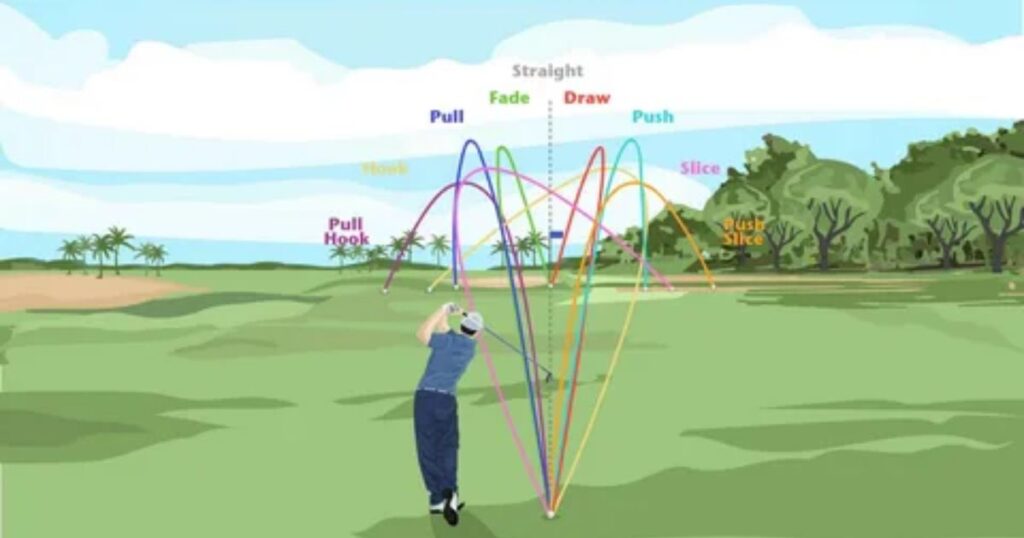Wind significantly impacts a golf ball’s flight path, causing it to deviate from its intended course. The speed and direction of the wind can make the ball curve or go off target. Golfers must carefully factor in wind conditions when making shots, adjusting their aim and club selection to compensate for these effects.
Have you ever wondered just how much does wind affect a golf ball? Wind can be the invisible opponent on the golf course, influencing the ball’s journey in unexpected ways. Understanding the extent of its impact is key to mastering this challenging aspect of the game. So, let’s explore the fascinating relationship between wind and the flight of a golf ball.
Understanding how much wind affects a golf ball is crucial for golfers. Wind can alter the ball’s path and distance, making accurate shots challenging. Staying with us will help you uncover strategies to navigate this element effectively and improve your game.
Factors Affecting Golf Ball Flight
Wind plays a pivotal role in golf ball trajectory. Headwinds, when the wind blows against the ball’s path, can cause the ball to lose lift and drop prematurely, resulting in reduced distance.
Conversely, tailwinds, when the wind blows in the same direction as the ball, can increase the ball’s distance and alter its trajectory. Understanding and adapting to these wind effects is crucial for golfers aiming to make accurate shots in varying conditions.
Golf ball flight is influenced by several key factors. The initial velocity of the ball, which is determined by the force of the clubhead striking the ball, plays a crucial role. Additionally, the launch angle, or the angle at which the ball leaves the clubface, significantly affects the trajectory. When it comes to the performance of your golf ball, it’s also important to tell if a golf ball is waterlogged, as this can impact its flight characteristics.
Spin rate is another essential factor, as it impacts the ball’s stability in the air. Furthermore, the wind’s speed and direction relative to the ball’s path can either help or hinder its flight.
Initial Ball Velocity
- Determined by the power and precision of the golfer’s swing.
- Higher initial velocity leads to longer shots.
- Influences a ball’s resistance to wind.
- Requires proper technique, timing, and club selection.
Launch Angle
- The angle at which the ball leaves the clubface.
- Affects trajectory and distance.
- Adjusted through swing and club selection.
- Important for overcoming wind and course obstacles.
Spin Rate
- Rate of ball rotation around its axis.
- Backspin and sidespin are primary types.
- Influences ball stability and green control.
- Controlled through swing mechanics and club choice.
Wind Speed and Direction
- Wind’s strength and direction affect ball flight.
- Headwinds reduce carry and distance.
- Tailwinds increase distance.
- Lateral wind movement impacts ball direction.
- Adjustments in club selection, aim, and trajectory are essential to compensate for wind effects.
The Wind’s Impact on Golf Ball Trajectory

When the wind blows, it can change how a golf ball travels. If you’re facing headwinds, the ball might not go as high and might fall sooner, making it go a shorter distance. But when you have tailwinds behind you, the ball can fly farther and might even change its path. Wind can be like a helping hand or a challenging obstacle for golfers.
Sometimes, the wind can also make the golf ball spin sideways. This means the ball might curve in the direction of the wind. And if there’s a lot of backspin, the wind can lift the ball higher, helping it travel longer distances. So, when you’re playing golf, it’s important to think about how the wind is blowing because it can change how your ball moves.
Effects of Headwinds
Lift and Drop
- Headwinds are winds blowing against the golf ball’s path.
- The headwind exerts an upward force on the ball, causing it to rise less.
- As the ball loses height quicker, it may result in a steeper descent.
Reduced Distance
- Headwinds act as a resistance force that opposes the ball’s forward movement.
- This resistance reduces the ball’s overall distance, making it fall shorter of the target.
- Golfers need to account for this reduced distance when selecting clubs and aiming.
Effects of Tailwinds
Increased Distance
- Tailwinds are winds blowing in the same direction as the golf ball’s flight path.
- These winds can help the ball by providing an additional push.
- This extra push from the tailwind can result in increased distance on the shot.
Altered Trajectory
- Tailwinds can influence the trajectory of the golf ball by reducing the effect of gravity.
- The ball may stay in the air longer, resulting in a flatter, extended trajectory.
- Golfers must adjust their aim and club selection to account for these altered ball flights.
How Wind Affects Ball Spin
Wind can make a golf ball spin in different ways. When the wind hits the ball from the side, it can cause it to spin to the left or right, making it curve in that direction. This makes it tricky to predict where the ball will go.
Additionally, if the wind is strong, it can affect the backspin on the ball. Strong winds can reduce the amount of backspin, making the ball drop faster and not travel as far. So, in windy conditions, golfers need to be aware of how the wind can change the way the ball spins and plan their shots accordingly.
Side Spin
- Curving in the Wind: Side spin refers to the rotation of a golf ball on its axis. When wind interacts with the ball’s sides, it can induce side spin, causing the ball to curve left or right. This curving effect is more pronounced in windy conditions, making it challenging for golfers to maintain a straight trajectory.
Backspin
- Impact on Lift and Carry: Backspin refers to the backward rotation of the golf ball. Wind can influence the amount of backspin on the ball. In windy conditions, strong headwinds can reduce backspin, causing the ball to drop more quickly and carry a shorter distance. Golfers must adjust their shots to account for this change in lift and carry.
Strategies for Dealing with Wind
When facing windy conditions on the golf course, it’s essential to choose the right club. Some clubs can help you counter the wind’s impact on your shots. Adjust your aim and trajectory as needed to compensate for the wind’s force. Stay focused mentally, and prepare to adapt your game to the ever-changing wind.
Putting in the wind can be tricky. Wind can make your putts less accurate. To improve your putting accuracy, pay close attention to the wind’s effect on the ball. Also, take time to read the greens carefully to adjust your putting strategy for the wind’s conditions.
Club Selection
- Choose the Right Tool for the Job: Selecting the appropriate club is crucial when dealing with wind. A lower-lofted club, such as a driver or a long iron, can help you penetrate headwinds, while a higher-lofted club might be more suitable for tailwinds.
- Understanding the Impact: When you choose the right club, you can mitigate the wind’s effect on your shot. A lower club will keep the ball lower and reduce its exposure to headwinds, while a higher club can help catch tailwinds for added distance.
- Adapting to Wind Speed: Consider the wind’s speed and direction when choosing your club. Strong winds may require a more significant adjustment in club selection compared to gentle breezes.
Adjusting Aim and Trajectory
- Compensating for Wind Drift: In windy conditions, your aim and trajectory need adjustments. For example, if the wind is blowing from left to right, aim slightly to the left of your target to compensate for the wind’s drift.
- Altering Ball Flight: Modify your shot trajectory to minimize the wind’s impact. Adjust the launch angle or swing path to counteract the wind’s effect on the ball’s path.
- Practice and Experience: Over time, experience and practice will help you become more adept at adjusting your aim and trajectory based on the wind conditions. Learning to read the wind’s subtleties is key to accurate adjustments.
Mental Preparation
- Stay Focused: Maintain mental composure in the face of challenging wind conditions. Avoid getting frustrated or distracted by the wind. Focus on your shots and your strategy.
- Expect Variability: Mentally prepare for the unpredictability of the wind. Wind can change direction and intensity, so adapt your mindset to handle these fluctuations.
- Confidence and Positivity: Cultivate a positive and confident mental attitude. Believe in your ability to adapt to the wind and make successful shots despite its challenges. Mental preparation can greatly impact your overall performance in windy conditions.
Wind and Putting
In the realm of golf, putting is a delicate art that can be significantly influenced by the presence of wind. Putting greens are particularly susceptible to the wind’s effects, and understanding how to adapt your game in these conditions is vital. Whether you’re facing headwinds or tailwinds, grasping the nuances of wind’s impact on putting is essential for consistent success on the greens.
How Wind Affects Putting Accuracy
When wind comes into play during putting, it can alter the trajectory and speed of the ball, making it more challenging to maintain accuracy. Headwinds can slow down the ball’s progress, while tailwinds can do the opposite. Recognizing the wind’s direction and intensity is the first step in adapting your putting strategy.
You’ll need to adjust your aim, the strength of your stroke, and your overall approach to ensure the ball reaches its intended target. The precision required for putting becomes even more crucial in windy conditions, as even a small deviation can lead to a missed putt.
Reading Greens in the Wind
Reading greens accurately is a fundamental skill in golf, and when the wind is in play, it becomes even more critical. Understanding how the wind may affect the break and speed of your putts is essential for success. Take time to assess the wind’s impact on the course layout, including any obstacles or terrain features that could further influence the wind’s path.
This knowledge will allow you to gauge how much the wind might affect your putts and help you make more precise judgments when lining up your shots. By mastering the art of reading greens in the wind, you can boost your putting accuracy and overall performance on the golf course.
FAQS
How does wind affect a golf ball’s trajectory?
Wind can lift or push a ball off course, altering its path and distance, depending on the wind’s direction and speed.
What are the best strategies for golfing in strong winds?
Choose lower-lofted clubs, adjust aim, and factor in the wind’s influence to maintain accuracy and distance.
How can I read greens effectively in windy conditions?
Observe the wind’s impact on nearby elements and consider how it may affect your putt’s break and speed.
Is mental preparation crucial for windy golf conditions?
Yes, maintaining focus, adaptability, and positivity in the face of wind challenges is vital for consistent performance.
Conclusion
In the world of golf, understanding “how much does wind affect a golf ball” is crucial. Wind’s influence can be the game-changer on the fairway, impacting a golf ball’s flight, spin, and ultimately, the player’s performance. By comprehending the nuances of wind’s effects, golfers can adapt their club selection, aim, trajectory, and mental readiness to overcome the challenges presented by windy conditions.
Embracing these strategies and staying focused, even in the face of unpredictable gusts, can lead to mastery of the elements and ultimately improved performance on the golf course. So, when the wind picks up, don’t let it be a hindrance; let it be an opportunity to











